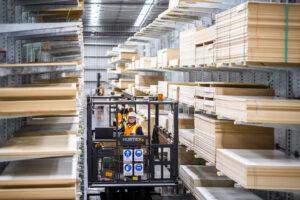Laminex’s sustainability strategy focuses on ‘what matters’

Jamie Rodriguez, Laminex Sustainability Manager. Photo credit: Laminex.
Manufacturer Laminex knows that a successful sustainability strategy starts with understanding what matters. The company has completed a ‘materiality assessment’ to identify and prioritise the environmental, social and governance topics it needs to focus on. ‘Material’ in this context means ‘important’.
Laminex New Zealand supplies high-quality countertops, vertical panels and timber-based building products. They manufacture decorated board and particleboard in Hamilton and Taupō. Laminex is part of Fletcher Building Group. The company is focused on its business’ long-term sustainability and helping to create environments that New Zealanders will enjoy for generations.
What is materiality assessment?
Materiality assessment is a structured way for a business to identify and understand what is important to its stakeholders. It uses qualitative research to identify important topics.
Laminex Sustainability Manager Jamie Rodriguez explains that a materiality assessment allows the manufacturer to deliver on its brand promise to go ‘Beyond the Surface’.
‘Customers are increasingly interested in our sustainability strategy,’ says Jamie. ‘They want to buy from a business that values people and the planet. Materiality assessment helped us to investigate deeply what Laminex’s stakeholders value most highly and what they want the business to deliver on.’
How Laminex carried out its materiality assessment
Step one: they identified their important stakeholders
Many people and organisations are involved with Laminex. They have an interest in how the business performs – operationally, socially, economically and environmentally.
Jamie began by dividing Laminex’s stakeholders into two groups – internal and external. Internal stakeholders included Laminex General Manager Mike Arthur and representatives across all departments such as Operational Managers, Health and Safety and Fletcher Building’s Mātauranga Māori (Māori knowledge) Senior Advisor.

Laminex team in the Auckland Distribution Centre. Photo credit: Laminex.
Customers like Kitchen Studios and architects who specify Lamine products featured on the list of external stakeholders. To help the team understand external influences on the industry, this group also included government agencies such as MBIE and organisations like the New Zealand Green Building Council.
Step two: they sought stakeholders’ feedback
To gain stakeholders’ views, Jamie and our thinkstep-anz team interviewed 16 stakeholders and ran a focus group. This work yielded 19 material topics. They included people topics (like health, safety and wellbeing), environmental topics (like minimising waste and reducing carbon emissions) and business topics (like customer service and innovation).
The company then surveyed a wider group of stakeholders online. They asked them to rank the 19 topics by using this question: From your perspective, how important should this topic be to Laminex?
Step three: they added the business lens
With this information in hand, Laminex’s leadership team considered the topics from a commercial point of view. They asked themselves: What do these topics mean for our reputation? Our profitability? The value we bring to society and the environment? Our business priorities?
Step four: they brought it all together
Laminex identified the topics that ranked highest for stakeholders’ importance (step two) and business impact (step three). All 19 topics raised in the materiality assessment are important. The highest-ranking topics form the foundations of Laminex’s strategy.
How materiality assessment is helping Laminex run its business
A clear, relevant strategy
The assessment has helped create a balanced strategy for Laminex’s sustainability – people, planet, business.
‘The outcomes of the materiality assessment have validated the great sustainability initiatives we are already doing,’ Jamie says. ‘They also guide us in the direction of other areas that the business should be focusing on now and into the future, with clear priorities and targets.’
Laminex employees are getting behind the strategy.
‘We gave everyone in the business the opportunity to have their say. At the end of the day, our people are the ones delivering on the strategy, so it was important that they were involved and felt heard throughout the process.’
Laminex customers support the strategy too. They see it as an opportunity to discover ways to work better together.
Parent company Fletcher Building is also supportive. Creating a sustainability strategy for Laminex builds links between the companies and helps them both deliver on common goals and targets.
Stronger relationships
Communicating the results of the assessment and acting on feedback has strengthened relationships with stakeholders and helped to engage them. The data Laminex has gained will help the company tailor activities and products to niche customers or areas of mutual interest.
New business opportunities and processes
The assessment has helped Laminex identify opportunities to innovate. For example, as a New Zealand-operated business, there is an opportunity to build Te Ao Māori (Māori principles) into how the business runs.
‘The materiality assessment gave us insightful information to help us create a strong sustainability strategy. It’s also created a ‘checklist’ of important topics that will guide Laminex’s future decisions’, said Jamie.
So much information just from asking a few questions!



